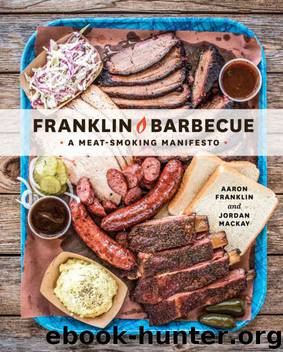Franklin Barbecue: A Meat-Smoking Manifesto by Aaron Franklin & Jordan Mackay

Author:Aaron Franklin & Jordan Mackay [Franklin, Aaron]
Language: eng
Format: epub
ISBN: 9781607747215
Publisher: Potter/TenSpeed/Harmony
Published: 2015-04-06T21:00:00+00:00
TUNING THE FIRE
Now that your fire is built, your coal bed is full and self-sustaining, your smoker has warmed to the right temperature, and wispy blue smoke is swirling from the stack, you’re ready to put the meat on. We’ll talk more about the meat in chapter five. But once you’ve put it on, you’re not going to do much with it for a long time. What you will be doing is constantly checking your temperatures and maintaining the fire. The most important pieces of equipment during this stage are your handy shovel, a thermometer to follow the temperatures in the cooker, and an ice chest full of cold beer.
Yes, this part is the long slog of barbecue, but it’s also the time to pull up a lawn chair, pop a beer, chat with friends, or, if you’re alone (as I often am on long cooks), simply reflect on life. You’ll learn to keep a near-constant eye on the fire, smokestack, and cooker temperature gauges. Generally, just looking at one of those will give you an indication of what’s going on. And periodically, you’ll get up to throw a log on or adjust the fire.
The goal at this stage is consistency. You want to keep your temperatures within the zone in which you’ve decided to cook (see chapter six for more on that). Inevitably they will rise and fall a bit, but get too far off course, and you can either damage your meat or you’ll find that it’s taking hours longer than you planned, which can be a problem if you have people waiting to eat.
It’s also important to remember that you have more control than you think. Even a chef in a modern kitchen will see a lag in time between when he or she turns up the dial in an oven versus when the food actually sees that heat. You will see that happen in a good smoker much more quickly. Smokers look clunky, heavy, and dull, but a well-built one will respond quickly to your adjustments. When I rummage through the woodpile looking for a piece that might give me another 10 degrees of heat and then I throw that small, dry piece on the fire, it might catch instantly. And when it does, thanks to that good airflow, that heat that the wood has just created will be whisked into the cook chamber within seconds. Because of that, I do feel I have the ability to control the temperature in the cook chamber almost in increments of degrees. (It’s just holding them there that’s the challenge.)
Skill at this part of managing a cook comes largely from experience. You have to know your wood, your smoker, and the weather conditions. Below I’m going to offer some of my techniques for managing the fire, but the best advice is to develop your own methods depending on your equipment.
Download
This site does not store any files on its server. We only index and link to content provided by other sites. Please contact the content providers to delete copyright contents if any and email us, we'll remove relevant links or contents immediately.
The Sprouting Book by Ann Wigmore(3543)
Better Homes and Gardens New Cookbook by Better Homes & Gardens(3523)
Trullo by Tim Siadatan(3378)
Super Food Family Classics by Jamie Oliver(3366)
Hedgerow by John Wright(3273)
Panini by Carlo Middione(3248)
Bread Revolution by Peter Reinhart(3080)
Sauces by James Peterson(3048)
Jam by Jam (epub)(3020)
Ottolenghi - The Cookbook by Yotam Ottolenghi(2869)
Oh She Glows Every Day by Angela Liddon(2726)
My Pantry by Alice Waters(2542)
Hot Sauce Nation by Denver Nicks(2450)
The Culinary Herbal by Susan Belsinger(2429)
Veg by Jamie Oliver(2408)
Wanderlust by Jeff Krasno(2225)
Meathooked by Marta Zaraska(2220)
The Art of Making Gelato by Morgan Morano(2215)
Basic Illustrated Edible and Medicinal Mushrooms by Jim Meuninck(2185)
